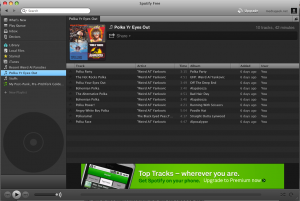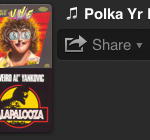Spotify is an online streaming music service that has been available in parts of Europe since 2008. It differentiates itself from popular US music services like Pandora and last.fm by permitting users to actually select the specific artists and songs to hear, rather than only relying upon an algorithm to choose music similar to a particular artist, song or style. In that way Spotify is more like a big online jukebox or iTunes, also permitting users to create playlists which can be shared with other users.
American music lovers who’d heard about the service waited anxiously to experience the kind of instant music availability enjoyed by listeners in Sweden, France and the UK. It took nearly three years, but after long negotiations with the major record labels Spotify became available in the US on July 14.
At first blush it certainly looks like Spotify poses a significant threat to streaming music services like Pandora, last.fm or Slacker, as well as subscription services like Rhapsody which also let listeners choose specific artists, albums and songs. I managed to swing an invitation to try out the free version of Slacker right after in launched stateside. After taking it for a test drive I can say that Spotify indeed does give these other services a run for the money, but I’m not certain that Spotify is ready to top them all.
As a free service it’s too limited to become someone’s go to music source the way that many people rely on Pandora, last.fm or internet radio. And I’m not yet convinced that Spotify’s paid service is complete enough for a lot of listeners like myself. Furthermore, it’s not really a radio service, so much as a very big jukebox in the cloud. Certainly there’s a lot to recommend that idea, but it’s also difficult to live up to.
Continue on to read my full detailed review of Spotify and find out what’s great, and what’s not.
Will it scale?
Most importantly, Spotify isn’t ready to become #1 because the service isn’t ready to take on enough free users to match the scale of Pandora or last.fm. Right now a free account is only available by invitation, whereas a free account with Pandora or last.fm is open to anyone. I presume this is because Spotify wants to scale carefully, rather than deal with a deluge of millions of new users crashing their systems. In fact, while free Spotify accounts were available to anyone for a while in the UK, the service is presently still only available by invitation there as well.
Prior to its US launch Spotify had 10 million users worldwide, with about 9 million of them free, ad supported accounts. By comparison Pandora has 80 million users and last.fm has 40 million. By user count alone Spotify has a way to go to beat the big two.
The Spotify difference
If you’re lucky enough to score a free Spotify account the experience indeed is different than Pandora or last.fm in several significant ways. First, Spotify requires its own application to run on your computer, with versions available for Windows, MacOS and Linux. For many users hoping to listen to music at work or school, places where one might not have the permission to install an application, this will be a barrier to using Spotify right away.
Pandora and last.fm both work inside your web browser. Now, this doesn’t mean that these services are available everywhere. Some schools and employers restrict access to streaming audio and video services. But if you’re currently a Pandora or last.fm listener at work or school it’s possible you won’t be able to install the Spotify app to enjoy that service.
At the same time there are advantages to having an app for Spotify. The app itself is pretty intuitive to use, borrowing quite a bit from the iTunes experience. Anyone who has used that nearly-ubiquitous Apple app or other music management software should have no problems getting started with Spotify’s quickly. Also, by not working in a browser Spotify minimizes the changes of dragging down your system or crashing your browser. The app also integrates with your iTunes library, giving you access to these tracks and playlists, too.
It’s very easy to search for artists, songs and albums. Just type in your search terms and hit enter. You’ll receive your results nearly instantaneously. Double-click on a track and you can be listening just as quickly. Compared to the web interfaces of Pandora and last.fm, Spotify is downright speedy. I’ve certainly been frustrated with Pandora and, especially, last.fm taking a long time to load a station, or failing to load altogether, sometimes requiring multiple page reloads.
Building a playlist is as easy with Spotify as in iTunes. Just click “new playlist” then select and drag songs to that playlist. It really seems like having a nearly limitless iTunes library at your fingertips. However, while Spotify has some 15 million tracks, it is not truly limitless.
A deep, but not bottomless, catalog
Just like other services there are some artists who are notably absent. Search for the Beatles, AC/DC, Frank Zappa or even King Crimson and you’ll only come up with covers by other artists. Bands like The Who or Pink Floyd have only a couple albums or a smattering of tracks available from their deep catalogs. These gaps aren’t limited to major artists either. In searching across many different genres I found that many artists only have some of their albums represented, or in some cases just a few songs from certain albums. I tried to see if missing albums were all on the same record label, but found that wasn’t necessarily the case.
Complaining about the catalog gaps in Spotify feels a bit like looking gift horse in the mouth, at least when you’ve got a free account and not paying a dime for the access and convenience. I must admit it’s nice to easily check out artists, albums and songs I’ve been interested in hearing rather than making do with thirty second clips.
The ad experience
Of course, just like its competitors (including commercial radio), Spotify isn’t really free. That free account is paid for by advertising that displays in the Spotify app and plays during the music stream. I was jarred by the first few ads I heard because they were for artists and albums that had no relationship to the music I was listening to. I just heard a whole different song start playing, making me think I’d accidenally clicked something. The first one I heard had no voiceover either, just a song snippet accompanied by display ad in the Spotify app. But because I had Spotify in the background I didn’t realize it at first.
I’ve gotten more used to the Spotify ads, but still find them to be more jarring than the last.fm and Pandora ads. On balance, the ads on the latter two services sound more like ones you hear on radio or television than the ones on Spotify.
Spotify has its (listening) limits
Like Pandora, Spotify’s free account sets a limit to how many hours you can listen to in a month. However, Spotify only offers 10 hours while Pandora offers four times as much. Especially if you listen while you work on other things, those 10 hours can run out before you know it. Last.fm does not limit listening time at all, giving it an advantage over the other two services.
Spotify offers unlimited listening on a computer in its Unlimited plan for $4.99 a month. At $9.99 a month the Unlimited plan offers “enhanced” sound quality and mobile access (more about that below). Pandora’s limitless listening is less expensive at $36 a year. This plan also includes higher quality audio, no ads and a desktop application rather than a browser-based player. Alternatively, for just 99 cents a user can keep listening past the 40 hour limit for the rest of the month, but without any of the other subscription benefits. There is no paid last.fm service — it’s completely free.
You can go mobile, for a price
Mobile devices are an area where the free Spotify service doesn’t compete at all. The mobile app is only available as a paid service with the Premium account at $9.99 a month. With that subscription you also get unlimited listening, higher quality sound files and an offline mode that lets you cache playlists on your computer or mobile device so you can listen without internet access.
Both Pandora and last.fm have free mobile apps. Pandora’s free mobile listening limits vary depending on your device and mobile service. Its $36 annual subscription removes any limit. Again, last.fm doesn’t have any limits in mobile, either.
It’s good to share
Despite the paranoia of the recording industry, sharing has been an important aspect of experiencing recorded music for decades. While Pandora and last.fm allow you to share a station that you’ve assembled, it’s not like sharing a mix CD or mix tape, since you can’t pick all the songs and artists. Spotify, on the other, let’s you share a full playlist with other Spotify users.
I think this is Spotify’s killer feature, because it most closely emulates the experience of a mix tape, as easy to assemble as making an iTunes playlist. Certainly there are other ways to share a playlist of tunes online, but most require you to either just share the list of songs which the other person would have to assemble herself. Otherwise you have to upload the song files yourself, which is something that exists in a legal grey area, at least in the US.
Every Spotify playlist has a big “share” button underneath the playlist name. Click it and you can send a link to facebook, twitter or Microsoft Messenger with one more click, or just copy and paste a URL that you can send in email or post to a blog. For an example, click here for a playlist of Weird Al Yankovic polka medleys I created.
I really saw the appeal of this feature when a few of my friends first started posting playlists to facebook. It really was like distributing a mixtape to all your friends simultaneously. Well, all of your friends who have Spotify accounts, at least.
And therein lies the limitation of Spotify’s sharing. Since not everyone who wants a Spotify account can have one yet, you really can’t send that playlist to everyone you know. Also, there will probably be songs you wish to include–such as anything by the Beatles–but aren’t available in Spotify’s catalog.
The Spotify experience: a little too limited, not quite radio
I have been a Pandora and last.fm listener for about two years. I don’t use either service every day, or even every week, but there are times when I want background music with a minimum of effort and a minimum of interruption. This is when they fit the bill. I’m not a Pandora subscriber, and have only run into its monthly limit a few times. In these few cases I’ve just switched over to last.fm, even if my stations are different due to each service’s unique algorithms and music libraries.
So far Spotify has become part of my mix of services. However, I use it differently, since I can create playlists of artists and tracks that I specifically want to hear, rather than the more randomized selection I can expect with Pandora or last.fm. In that way I’m likely to use Spotify more like I use my own iTunes library. Of course, I can choose to listen to Spotify’s artist radio and get a similar experience. But as a free user I’d rather not use up my 10 hours getting an experience similar to Pandora or last.fm which have a higher and no limit, respectively.
The big question, of course, is, would I buy a Spotify subscription? I can see the attraction of the service. Having that enormous library of music available on demand, online and off, is appealing. Yet, for someone like me, that library isn’t quite enormous enough. The missing artists, albums and songs are quite tolerable for a free service, but less so when I’m coughing up a monthly fee.
Frankly, if I’d wanted a paid music service I’d already be Rhapsody subscriber. That service costs the same as Spotify Premium, offers similar desktop and mobile features, and has been available in the US for much longer. However Rhapsody also has gaps in its catalog, missing artists like the Beatles and AC/DC which aren’t found on Spotify, either.
Is it radio?
Pandora and last.fm are most appealing to me because they are radio-like and free. If I want to control the playlist, I’ll build one from my library. I listen to Pandora and last.fm when I want to relinquish some of that control and maybe be surprised. But I’m not particularly ready to pay for the experience.
I will admit that Spotify’s free service is nice to use, but 10 hours is a pretty low limit. Based on that alone I think it will have a tough fight to unseat Pandora or last.fm from a lot of music lovers’ daily listening routine.
Spotify shows promise, but is not ready to be a mainstream service accessible to most internet users. It also doesn’t quite scratch that radio itch. A jukebox is not the same thing as a radio station. For me the radio music experience is marked by a combination of predictability and surprise. I know the genre of the stations or the specific show, but I don’t know what song will come next; often it will be something I’ve never heard before. Both Pandora and last.fm provide something much closer to that radio experience, combined with a level of control that lets you filter out sounds you don’t want to hear.
While Spotify has a radio option that resembles Pandora and last.fm, there isn’t much reason to use it compared to its unique playlist building feature. There are times when you want a jukebox, and for many of us our iTunes library is actually pretty satisfying, given that it contains only music I’ve selected and acquired. Spotify comes close, but not close enough for me.
There may be many music lovers ready to just rent their music through a paid Spotify account, provided their tastes don’t stray too far from Spotify’s catalog too often. However, I truly do not know how many. I do know I won’t be one.





